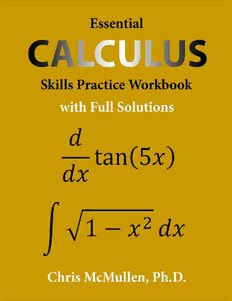
Calculus Essential calculus skills practice workbook with full solutions An easy nice book for starting beginners guide Foundation PDF
Preview Calculus Essential calculus skills practice workbook with full solutions An easy nice book for starting beginners guide Foundation
Essential Calculus Skills Practice Workbook with Full Solutions Improve Your Math Fluency Chris McMullen, Ph.D. Copyright © 2018 Chris McMullen, Ph.D. monkeyphysicsblog.wordpress.com improveyourmathfluency.com chrismcmullen.com Zishka Publishing All rights reserved. Version 2.07.18A Textbooks > Math > Calculus Study Guides > Workbooks> Math Education > Math > Calculus Paperback ISBN: 978-1-941691-24-3 Contents Introduction 1 DERIVATIVES OF POLYNOMIALS Chapter 1 Exercises Chapter 1 Solutions 2 THE CHAIN RULE, PRODUCT RULE, AND QUOTIENT RULE Chapter 2 Exercises Chapter 2 Solutions 3 DERIVATIVES OF TRIG FUNCTIONS Chapter 3 Exercises Chapter 3 Solutions 4 DERIVATIVES OF EXPONENTIALS Chapter 4 Exercises Chapter 4 Solutions 5 DERIVATIVES OF LOGARITHMS Chapter 5 Exercises Chapter 5 Solutions 6 SECOND DERIVATIVES Chapter 6 Exercises Chapter 6 Solutions 7 EXTREME VALUES Chapter 7 Exercises Chapter 7 Solutions 8 LIMITS AND L’HÔPITAL’S RULE Chapter 8 Exercises Chapter 8 Solutions 9 INTEGRALS OF POLYNOMIALS Chapter 9 Exercises Chapter 9 Solutions 10 DEFINITE INTEGRALS Chapter 10 Exercises Chapter 10 Solutions 11 INTEGRALS OF TRIG FUNCTIONS Chapter 11 Exercises Chapter 11 Solutions 12 INTEGRALS OF EXPONENTIALS AND LOGARITHMS Chapter 12 Exercises Chapter 12 Solutions 13 INTEGRATION BY POLYNOMIAL SUBSTITUTION Chapter 13 Exercises Chapter 13 Solutions 14 INTEGRATION BY TRIGONOMETRIC SUBSTITUTION Chapter 14 Exercises Chapter 14 Solutions 15 INTEGRATION BY PARTS Chapter 15 Exercises Chapter 15 Solutions 16 MULTIPLE INTEGRALS Chapter 16 Exercises Chapter 16 Solutions Introduction This workbook is designed to help practice essential calculus techniques, especially the art of finding derivatives and performing integrals. Each chapter focuses on one main topic such as how to apply the chain rule or how to perform an integral with a trigonometric substitution. Every chapter begins with a concise explanation of the main concept, followed by a few examples. The examples are fully solved step-by-step with explanations, and should serve as a valuable guide for solving the practice problems. The solution to every practice exercise is tabulated at the back of the book. A variety of essential calculus skills are covered in this workbook. The first chapter starts out simple with derivatives of polynomials, and the difficulty of the lessons progresses as the book continues. Students will learn: • how to find derivatives and anti-derivatives of polynomials • how to find derivatives and anti-derivatives of trigonometric functions • how to find derivatives and anti-derivatives of logarithms and exponentials • how to perform definite integrals • how to perform multiple integrals • a variety of integration techniques May you (or your students) find this workbook useful and become more fluent with these essential calculus skills. 1 DERIVATIVES OF POLYNOMIALS Given a polynomial term of the form axb (where a is a constant coefficient and b is a constant exponent), to take a derivative with respect to the variable x, first multiply the coefficient a by the exponent b, and then reduce the exponent by 1 according to the following formula: Note that a few special exponents can make a polynomial look somewhat different: • If you see a variable in a denominator, you may bring it to the numerator by negating its exponent according to the following rule: • If you see a squareroot, rewrite it using an exponent of ½: • If no coefficient or exponent is observed, the number 1 is implied: It may help to recall the following rules of algebra regarding exponents: If a polynomial includes multiple terms, find the derivative of each term individually and then add the results together: For example, if y = 4x2, y = –3x, and y = 6, this means: 1 2 3 Note that the derivative of a constant equals zero: Example: Perform the following derivative with respect to x.
